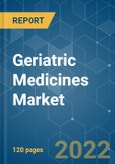The geriatric medicines market studied was anticipated to witness a CAGR of nearly 6.5% during the forecast period. The primary factor attributing to the growth of the market is a steep rise in the elderly population across geographical locations, mainly in developed and emerging economies. Besides, the rising prevalence of chronic disorders, such as cancers, diabetes, and rheumatoid arthritis among the geriatrics attributes for the growth of the market. For instance, according to the United Nations data of World Population Prospects for the year 2019, the number of people over the age of 65 increases from 9% in 2019 to more than 16% of the total world’s population by 2050. The number of persons aged 80 years or over is also projected to triple, from 143 million in 2019 to 426 million in 2050. Thus, the rise in the volume of the patient pool results in a higher demand for the market fueling the global market growth over the forecast period.
Key Market Trends
Analgesics in the Therapeutics Segment is Expected to Hold the Largest Market Share in the Geriatric Medicines Market
The analgesics segment is expected to account for the most significant revenue over the forecast period as it is the most common indication with a high occurrence rate of pain-related syndromes in the elder age. This dominance is due to the occurrence of various reasons, such as osteoporosis, lack of musculoskeletal strength, vision impairment, and unintentional falls leading to unbearable pain in that age. Thus, owing to several distinct syndromes, the demand for proper analgesic therapy increases with the rise in prescription sales for pain management is more and is anticipated to the growth of the segment. On the other hand, the anti-diabetic segment is expected to witness the fastest CAGR due to the increasing global burden of diabetes in the elderly age group, which results in other ailments resulting in higher demand for the segment driving the market revenue over the forecast period.
North America Dominates the Market and Expected to do Same in the Forecast Period
North America is expected to dominate the overall geriatric medicines market throughout the forecast period. The dominance is due to the growing prevalence of various chronic diseases like obesity and diabetes, the presence of a vast population of baby boomers during the forecast period in the United States necessitated efficient treatment. For instance, according to the International Diabetes Federation in 2019, about 48 million adults in North America are living with diabetes, among which more than half of the patients are over the age of 65 and are expected to continue in the future resulting in higher demand for the specific treatment for geriatric population driving the market in the region. Moreover, the rise in demand for geriatric care can be attributed to the increased side-effects due to several interactions among various medicines associated with the poly-pharmacy, especially those who are not residing in nursing homes, rise in government initiatives to enhance the awareness, a well-developed compensation scenario along with increased availability of advanced healthcare infrastructure and huge investments by the key players in the region are likely to fuel the market growth contributing to its outstanding market share in the geriatric medicines market.
Competitive Landscape
The geriatric medicines market is moderately competitive and consists of several major players. Few of the prominent players currently dominating the market are implementing various strategies like developing products specific to elderly patients minimizing the side effects while some others are focusing on the R&D activities, applying for Investigational New Drug (IND) application approvals with huge product pipelines to treat rare autoimmune disorders which are more prevalent in these patients to consolidate their market positions across the globe. For example, in September 2019, Akari Therapeutics PLC, a biopharmaceutical company focused on innovative therapeutics to treat orphan autoimmune and inflammatory diseases has received orphan drug designation for nomacopan from the US Food and Drug Administration (FDA), which was successfully proven efficient in animals models of Guillain-Barre syndrome driving the market growth. Some of the companies currently dominating the market are Endo Pharmaceuticals Inc., Merck & Co. Inc., AstraZeneca PLC, Pfizer Inc., and Allergan Inc.
Additional Benefits:
- The market estimate (ME) sheet in Excel format
- 3 months of analyst support
This product will be delivered within 2 business days.
Table of Contents
Methodology

LOADING...








